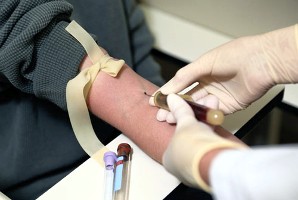28 July 2014. A team from University of Bradford in the U.K. developed a simple blood test, which in early tests suggests it could screen patients for common types of cancer. The researchers led by medical sciences professor Diana Anderson published their findings last Friday in FASEB Journal, published by Federation of American Societies for Experimental Biology, and started a company to commercialize the technology.
Anderson — with colleagues from Bradford, University of Wolverhampton, and Bradford Royal Infirmary — are seeking a simple and inexpensive way for physicians to test for the presence of cancer in patients, without submitting the patients to costly and invasive tests such as colonoscopies and biopsies. In addition, a test of this kind could find early indications of cancer, which for some types would otherwise be difficult to diagnose.
The lymphocyte genome sensitivity test developed by the Bradford team measures the damage to DNA of lymphocytes, or white blood cells in the body’s immune system, since ultraviolet light can damage DNA. When battling cancer, lymphocytes are subjected to a great deal of stress, and the researchers guessed ultraviolet light would damage lymphocyte DNA even further when already under the strain of cancer.
To test this hunch, Anderson and colleagues took blood tests from 208 individuals in Bradford, 94 healthy volunteers from the university and 114 patients referred to Bradford Royal Infirmary for cancer tests and treatment. The blood samples were blinded (made anonymous) and randomized, then subjected to ultraviolet rays through 5 layers of agar, a gelatinous substance for hosting lab cultures.
The researchers measured the damage to DNA with a technique called olive tail moment, where damaged DNA breaks into pieces and is drawn out from the nucleus in an electric field. The size of this drawn-out tail acts as an indicator of damage to DNA, since the greater the damage to DNA, the more pieces would be generated, and thus the longer tail that develops.
The results show a strong correlation between the lymphocyte genome sensitivity measures and a diagnosis of either precancerous conditions or actual cases of cancer. Likewise, the test returned neither suspected nor actual cancer conditions among the healthy volunteers. The differences in test results between the healthy volunteers and pre-cancer or cancer patients were large enough to be statistically reliable, where the possibility of the findings happening by chance are less than 1 in 1,000.
“Whilst the numbers of people we tested are, in epidemiological terms, quite small, in molecular epidemiological terms, the results are powerful,” says Anderson in a university statement. “We believe that this confirms the test’s potential as a diagnostic tool.”
The researchers started a clinical trial at Bradford Royal Infirmary to evaluate the lymphocyte genome sensitivity test’s performance in predicting if patients referred by primary care physicians for suspected colon cancer would benefit or not from a colonoscopy.
Bradford University filed patents for the test technology. In addition, members of the research team plan to take the lymphocyte genome sensitivity test to market with a spin-off company called Oncascan that licensed the technology from the university for development. Anderson serves as one of the company’s scientific advisors.
Read more:
- Spin-Off Company Developing Cardiac Drug Tests
- Chip Device Developed to Quickly Test for Type 1 Diabetes
- Spin-Off Licenses Genomic Technology from Wash. University
- Quest, Sloan Kettering Partner on Solid Tumor Diagnostics
- Genetic Blood Transfusion Diagnostic Approved by FDA
* * *


 RSS - Posts
RSS - Posts
You must be logged in to post a comment.